678. Croaking Cisticola Cisticola natalensis (Groottinktinkie)
Order: Passeriformes. Family: Cisticolidae
Description
13-17 cm. A large, bulky Cisticola with a thick bill. It is grey-brown above, heavily streaked with black. The underparts are whitish, and the tail is broad, pale-tipped and flicked frequently, shorter tailed when in breeding plumage. It has a chestnut wing-panel and a heavy bill. Note lack of rufous in the head markings and well marked back.
Distribution
Across much of sub-Saharan Africa, with one population in West Africa from Gambia to Gabon, and another extending from Ethiopia through Tanzania, Zambia and Angola to southern Africa. Here it is locally common in eastern SA and Mozambique, widespread in Zimbabwe.
Habitat
Grassland with scattered bushes, grassy hillsides. Generally shy, but uses prominent perch when displaying or giving alarm calls.
Diet
It mainly eats invertebrates, gleaning prey from the undergrowth and bare soil.
Breeding
It builds an oval or ball-shaped framework with a side entrance from living grass, which it then fills in with dry grass. It is typically placed in a large tuft of green grass close to the ground surface. It may build several nests in total, but it only uses one in the end. Egg-laying season is from October-March. The chicks are fed a variety of insects, staying in the nest for about 14-15 days.
Call
A froglike croaking breep-breep song. Listen to Bird Call.
Status
Common, localised resident.
Africa Wild Bird Book
Croaking Cisticola
Dewi
What is the good of having a nice house without a decent planet to put it on? (H D Thoreau)
What is the good of having a nice house without a decent planet to put it on? (H D Thoreau)
Croaking Cisticola Photos
678. Croaking Cisticola Cisticola natalensis
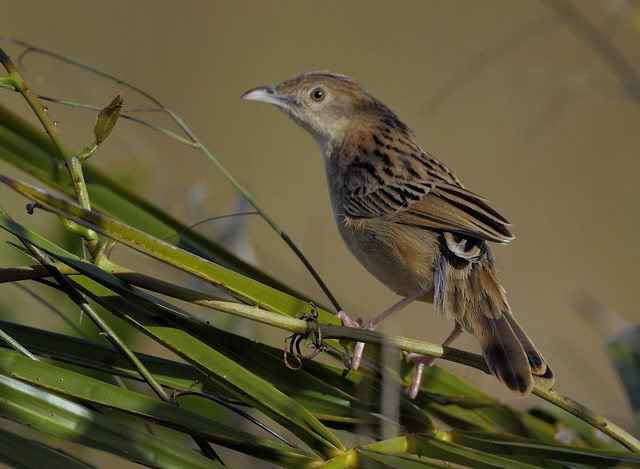
Non-breeding
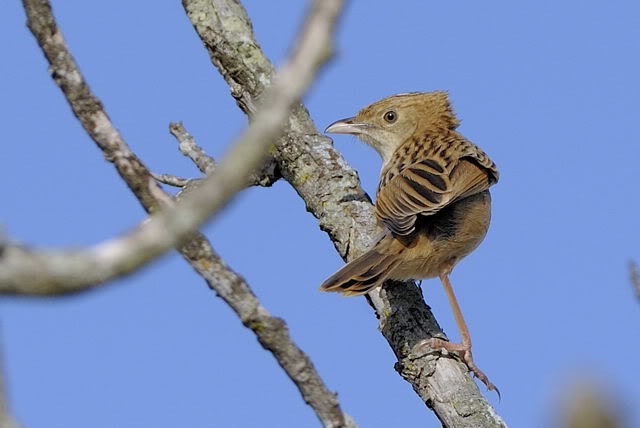
Non-breeding
Links:
Species text Sabap1
Sabap2

Non-breeding

Non-breeding
Links:
Species text Sabap1
Sabap2
Dewi
What is the good of having a nice house without a decent planet to put it on? (H D Thoreau)
What is the good of having a nice house without a decent planet to put it on? (H D Thoreau)
Neddicky
681. Neddicky Cisticola fulvicapilla (Neddikkie)
Order: Passeriformes. Family: Cisticolidae

Northern Race
Description
11 cm. An uniformly brown or grey backed Cisticola with grey to buff underparts with a rufous cap and a relatively short tail, brownish grey, constantly flicked sideways (tail long in Lazy Cisticola), no terminal markings. The underparts are buff (never streaked), darker in tone on the breast (more northerly populations browner above, whiter below). The brown bill is short and straight, and the feet and legs are pinkish-brown. The eye is light brown, indistinct buffy eyering. The sexes are similar.
Juvenile birds are yellower.
The Northern Race (northern South Africa and northwards) is generally buffier than the Southern Race. The southern form found in the Western Cape Province has grey underparts and a grey-brown back.
Distribution
From southern Tanzania, Angola and Zambia to southern Africa. Eastern half of the Sub-region, extending westwards to the Cape in the South.
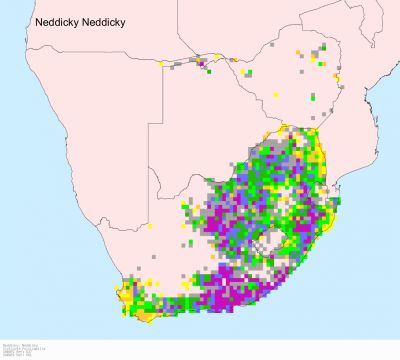
Habitat
Rocky scrubland. Understorey of broad-leaved woodland, savanna and plantations.
Diet
It mainly eats insects, doing most of its foraging on the ground the ground beneath undergrowth, hopping after flying or jumping insects.
Breeding
Breeds widely in the savanna, grassland and fynbos regions, mainly in mesic areas and where there is good grass cover and scattered trees in the vicinity.
The nest is built solely by the female, and is typically an oval or ball shape with a side entrance, although it may rarely construct a cup instead. It builds it out of dry grass secured with spider web, with the female adding a soft plant down lining to the inside and also to below the side entrance (forming a kind of doormat). It is usually placed low down in a grass tuft, herb or forb, very near to the ground surface. Egg-laying season is from September-March, peaking from October-January. It lays 2-5 eggs, which are incubated for about 12-15 days. The chicks leave the nest after about 12-15 days.
Call
The call of the Neddicky is a monotonous, penetrating, repetitive weep weep weep. The alarm call is a loud clicking tic-tic-tic-tic. Listen to Bird Call.
Status
Common resident.
Order: Passeriformes. Family: Cisticolidae

Northern Race
Description
11 cm. An uniformly brown or grey backed Cisticola with grey to buff underparts with a rufous cap and a relatively short tail, brownish grey, constantly flicked sideways (tail long in Lazy Cisticola), no terminal markings. The underparts are buff (never streaked), darker in tone on the breast (more northerly populations browner above, whiter below). The brown bill is short and straight, and the feet and legs are pinkish-brown. The eye is light brown, indistinct buffy eyering. The sexes are similar.
Juvenile birds are yellower.
The Northern Race (northern South Africa and northwards) is generally buffier than the Southern Race. The southern form found in the Western Cape Province has grey underparts and a grey-brown back.
Distribution
From southern Tanzania, Angola and Zambia to southern Africa. Eastern half of the Sub-region, extending westwards to the Cape in the South.

Habitat
Rocky scrubland. Understorey of broad-leaved woodland, savanna and plantations.
Diet
It mainly eats insects, doing most of its foraging on the ground the ground beneath undergrowth, hopping after flying or jumping insects.
Breeding
Breeds widely in the savanna, grassland and fynbos regions, mainly in mesic areas and where there is good grass cover and scattered trees in the vicinity.
The nest is built solely by the female, and is typically an oval or ball shape with a side entrance, although it may rarely construct a cup instead. It builds it out of dry grass secured with spider web, with the female adding a soft plant down lining to the inside and also to below the side entrance (forming a kind of doormat). It is usually placed low down in a grass tuft, herb or forb, very near to the ground surface. Egg-laying season is from September-March, peaking from October-January. It lays 2-5 eggs, which are incubated for about 12-15 days. The chicks leave the nest after about 12-15 days.
Call
The call of the Neddicky is a monotonous, penetrating, repetitive weep weep weep. The alarm call is a loud clicking tic-tic-tic-tic. Listen to Bird Call.
Status
Common resident.
Dewi
What is the good of having a nice house without a decent planet to put it on? (H D Thoreau)
What is the good of having a nice house without a decent planet to put it on? (H D Thoreau)
Neddicky Photos
681. Neddicky Cisticola fulvicapilla (Neddikkie)
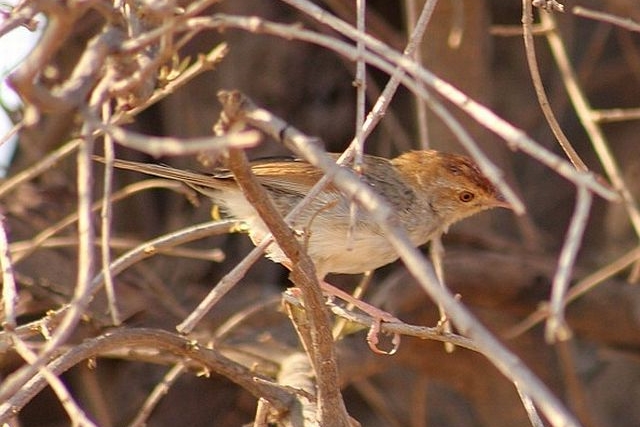 © Amoli
© Amoli
Northern Race, Pilanesberg
 © Dewi
© Dewi
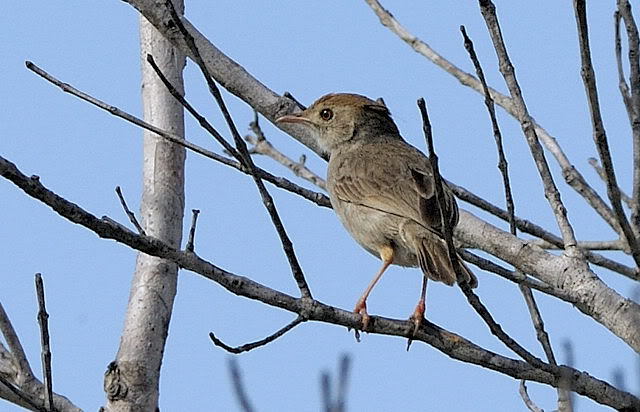 © Dewi
© Dewi
Southern Race
Northern Race, Pilanesberg © BluTuna
Links:
Species text Sabap1
Sabap2: http://sabap2.adu.org.za/species_info.p ... #menu_left
 © Amoli
© AmoliNorthern Race, Pilanesberg
 © Dewi
© Dewi © Dewi
© DewiSouthern Race
Northern Race, Pilanesberg © BluTuna
Links:
Species text Sabap1
Sabap2: http://sabap2.adu.org.za/species_info.p ... #menu_left
Dewi
What is the good of having a nice house without a decent planet to put it on? (H D Thoreau)
What is the good of having a nice house without a decent planet to put it on? (H D Thoreau)
Zitting Cisticola
664. Zitting Cisticola Cisticola juncidis (Landeryklopkloppie)
Order: Passeriformes. Family: Cisticolidae
Description
10 cm. A small, short tailed Cisticola with well marked head, back and tail. Tail is often fanned and shows a black subterminal band with white tips. The tail is more boldly marked than in other small cisticolas. Underparts are buff, but generally paler on the breast.
Distribution
Extremely widespread, occurring from southern Eurasia to northern Australia and sub-Saharan Africa, all the way down to southern Africa.
Habitat
Tall, thick grass and reed-beds in damp areas.
Diet
It eats insects (mostly grasshoppers), doing most of its foraging low down, gleaning prey from the bases of grass tufts and the bare soil.
Breeding
The nest is a unique pear shape with a side entrance, built of spider web and plant down woven into a framework of the tuft of green grass in which it is typically placed. The male builds an outer framework and, if approved by the female, continues to finish it; the whole process usually takes about 12-17 days. If the female does not like the look of it, he often destroys it and recycles the material to build another one. Once the eggs are laid, the female adds a lining to the interior during incubation. Egg-laying season is from August-April, peaking from November-February. The female lays 2-5 eggs, which are incubated solely by the female for about 12-15 days. The chicks are mainly fed by the female, leaving the nest after about 11-15 days.
Call
The Zitting Cisticola simply gives sharp zit-zit-zit-notes every second, like a ticking watch. Listen to Bird Call.
Status
Common breeding resident.
Order: Passeriformes. Family: Cisticolidae
Description
10 cm. A small, short tailed Cisticola with well marked head, back and tail. Tail is often fanned and shows a black subterminal band with white tips. The tail is more boldly marked than in other small cisticolas. Underparts are buff, but generally paler on the breast.
Distribution
Extremely widespread, occurring from southern Eurasia to northern Australia and sub-Saharan Africa, all the way down to southern Africa.
Habitat
Tall, thick grass and reed-beds in damp areas.
Diet
It eats insects (mostly grasshoppers), doing most of its foraging low down, gleaning prey from the bases of grass tufts and the bare soil.
Breeding
The nest is a unique pear shape with a side entrance, built of spider web and plant down woven into a framework of the tuft of green grass in which it is typically placed. The male builds an outer framework and, if approved by the female, continues to finish it; the whole process usually takes about 12-17 days. If the female does not like the look of it, he often destroys it and recycles the material to build another one. Once the eggs are laid, the female adds a lining to the interior during incubation. Egg-laying season is from August-April, peaking from November-February. The female lays 2-5 eggs, which are incubated solely by the female for about 12-15 days. The chicks are mainly fed by the female, leaving the nest after about 11-15 days.
Call
The Zitting Cisticola simply gives sharp zit-zit-zit-notes every second, like a ticking watch. Listen to Bird Call.
Status
Common breeding resident.
Dewi
What is the good of having a nice house without a decent planet to put it on? (H D Thoreau)
What is the good of having a nice house without a decent planet to put it on? (H D Thoreau)
Zitting Cisticola Photos
664. Zitting Cisticola Cisticola juncidis (Landeryklopkloppie)
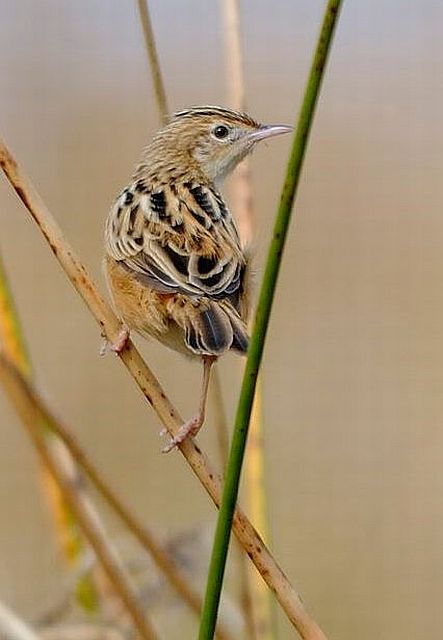 © Dewi
© Dewi
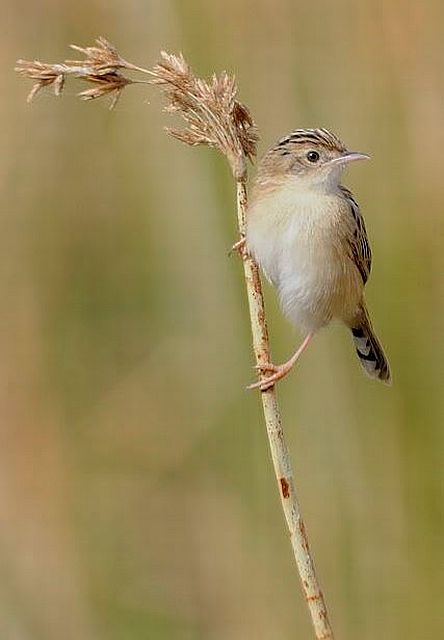 © Dewi
© Dewi
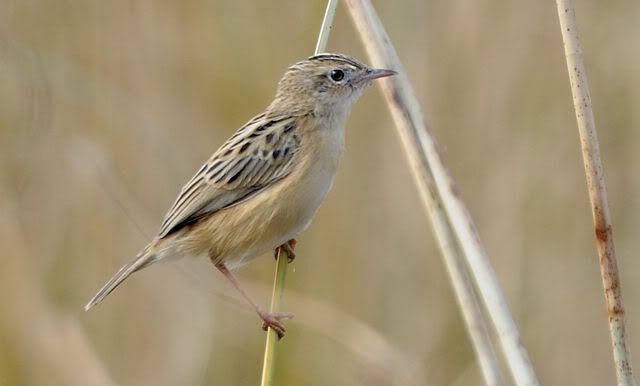 © Dewi
© Dewi
 © nan
© nan
 © nan
© nan
Strandfontein Sewage Works
Links:
Species text Sabap1
Sabap2: http://sabap2.adu.org.za/spp_summary.ph ... §ion=3
Chamberlain's LBJ's
 © Dewi
© Dewi © Dewi
© Dewi © Dewi
© Dewi © nan
© nan © nan
© nanStrandfontein Sewage Works
Links:
Species text Sabap1
Sabap2: http://sabap2.adu.org.za/spp_summary.ph ... §ion=3
Chamberlain's LBJ's
Dewi
What is the good of having a nice house without a decent planet to put it on? (H D Thoreau)
What is the good of having a nice house without a decent planet to put it on? (H D Thoreau)
- Sprocky
- Posts: 7121
- Joined: Sat May 19, 2012 12:29 pm
- Country: South Africa
- Location: Grietjie Private Reserve
- Contact:
Desert Cisticola
665. Desert Cisticola Cisticola aridulus (Woestynklopkloppie)
Order: Passeriformes. Family: Cisticolidae
Description
Length 10-12 cm, weight 13 g. Tiny, pale streaky cisticola. Upperparts pale brown to buff with blackish streaks on the crown and back. Underparts whitish; breast, flanks and undertail coverts pale buff. Like Zitting Cisticola with a plain rufous-buff rump. Sexes alike, but the female has a shorter tail.
Juvenile is paler below.
Similar species: It resembles Zitting Cisticola but is overall paler, tail-tip less boldly marked, lacks conspicuous black subterminal tail band. The tail is shorter and white-tipped. It occupies drier habitats.
Also similar to the Cloud Cisticola and the Wing-snapping Cisticola.
Distribution
It occurs in patches along the Sahel semi-desert, extending south to Ethiopia and Tanzania, with a separate population from Angola and Zambia to southern Africa. In southern Africa, widespread in dry grassland of the interior; but absent from semi-arid and arid south-west and lowlands of the east.
Habitat
Desert grasslands and old croplands. It may also occupy other types of dry grassland, sometimes with scattered trees and bushes.
Diet
Insectivorous. It eats small invertebrates, such as spiders, grasshoppers (Orthoptera) and beetles. It does most of its foraging low down in grassland, gleaning prey from the grass and bare soil.
Breeding
Monogamous. The nest is pear-shaped, with a large base and an entrance towards the side of the smaller roof. It is usually built of dry grass reinforced and attached with spider web to a grass tuft, typically less than half a metre above ground. Egg-laying season is from about October-April, peaking from December-March. It lays 2-5 eggs, which are probably incubated solely by the female in about 14 days. The chicks stay in the nest for about 13-18 days, producing a sharp hissing noise if touched.
Parasitized by Cuckoo Finch.
Call
A fast ting-ting-ting-ting-ting... then staccato clicks. Listen to Bird call.
Status
Locally common resident in drier regions.
Order: Passeriformes. Family: Cisticolidae
Description
Length 10-12 cm, weight 13 g. Tiny, pale streaky cisticola. Upperparts pale brown to buff with blackish streaks on the crown and back. Underparts whitish; breast, flanks and undertail coverts pale buff. Like Zitting Cisticola with a plain rufous-buff rump. Sexes alike, but the female has a shorter tail.
Juvenile is paler below.
Similar species: It resembles Zitting Cisticola but is overall paler, tail-tip less boldly marked, lacks conspicuous black subterminal tail band. The tail is shorter and white-tipped. It occupies drier habitats.
Also similar to the Cloud Cisticola and the Wing-snapping Cisticola.
Distribution
It occurs in patches along the Sahel semi-desert, extending south to Ethiopia and Tanzania, with a separate population from Angola and Zambia to southern Africa. In southern Africa, widespread in dry grassland of the interior; but absent from semi-arid and arid south-west and lowlands of the east.
Habitat
Desert grasslands and old croplands. It may also occupy other types of dry grassland, sometimes with scattered trees and bushes.
Diet
Insectivorous. It eats small invertebrates, such as spiders, grasshoppers (Orthoptera) and beetles. It does most of its foraging low down in grassland, gleaning prey from the grass and bare soil.
Breeding
Monogamous. The nest is pear-shaped, with a large base and an entrance towards the side of the smaller roof. It is usually built of dry grass reinforced and attached with spider web to a grass tuft, typically less than half a metre above ground. Egg-laying season is from about October-April, peaking from December-March. It lays 2-5 eggs, which are probably incubated solely by the female in about 14 days. The chicks stay in the nest for about 13-18 days, producing a sharp hissing noise if touched.
Parasitized by Cuckoo Finch.
Call
A fast ting-ting-ting-ting-ting... then staccato clicks. Listen to Bird call.
Status
Locally common resident in drier regions.
Sometimes it’s not until you don’t see what you want to see, that you truly open your eyes.
- Sprocky
- Posts: 7121
- Joined: Sat May 19, 2012 12:29 pm
- Country: South Africa
- Location: Grietjie Private Reserve
- Contact:
Desert Cisticola Photos
665. Desert Cisticola Cisticola aridulus (Woestynklopkloppie)
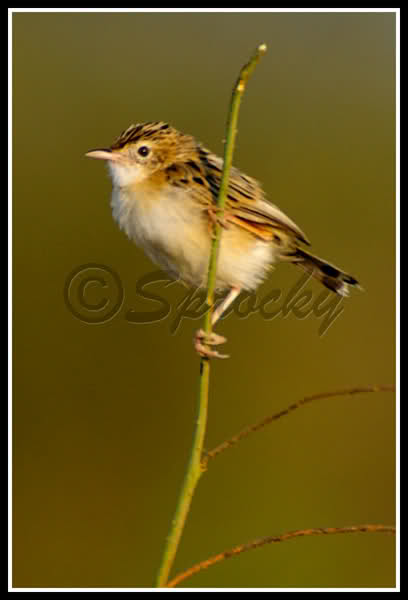 © Spricky
© Spricky
 © nan
© nan
Kgalagadi Transfrontier Park, Grootkolk
 © Michele Nel
© Michele Nel
Kgalagadi Transfrontier Park, Twee Rivieren - Jan 2016
Links:
Species text Sabap1
Sabap2: http://sabap2.adu.org.za/spp_summary.ph ... §ion=3
Chamberlain's LBJ's
SASOL VOELS VAN SUIDER AFRICA (3de UIT)
 © Spricky
© Spricky © nan
© nanKgalagadi Transfrontier Park, Grootkolk
 © Michele Nel
© Michele NelKgalagadi Transfrontier Park, Twee Rivieren - Jan 2016
Links:
Species text Sabap1
Sabap2: http://sabap2.adu.org.za/spp_summary.ph ... §ion=3
Chamberlain's LBJ's
SASOL VOELS VAN SUIDER AFRICA (3de UIT)
Sometimes it’s not until you don’t see what you want to see, that you truly open your eyes.
Cloud Cistcola
666. Cloud Cisticola Cisticola textrix (Gevlekte klopkloppie)
Order: Passeriformes. Family: Cisticolidae
Description
A small cisticola (length 9-10 cm) with very short, rounded tail and streaked upperparts, spotted below; voice diagnostic; above tawny, broadly streaked blackish; crown almost plain light brown in breeding male; below white, washed buff on flanks, slightly streaked dark brown on sides of breast (whole breast and flanks streaked in birds from S Cape and E Orange Free State; diagnostic). Iris light brown; bill dark horn, base yellowish pink; legs and feet pinkish brown.
Juvenile: Below bright lemon yellow.
Distribution
South Africa to Angola and Zaire; in South Africa confined to extreme SW, S and highveld to N Gauteng.
Habitat
It prefers open grassland with patches of bare soil, both tall and short varieties, occasionally in love grass (Eragrostis) pastures and clumps of restios.
Diet
It mainly eats invertebrates, especially grasshoppers (Orthoptera) but also spiders, foraging in the undergrowth and bare soil.
Breeding
The nest is a ball shape with a side entrance, built of dry grass and lined with plant down. It is typically placed close to the ground in a grass tuft, the leaves of which are incorporated into then nest, effectively concealing it. Egg-laying season is from August-March. The female lays 2-4 eggs, which are incubated for about 14 days. The chicks leave the nest after about 15-16 days.
Call
Song, always in high cruising flight, rapid high-pitched set phrase, tik-tik-tik-tik see-see chik-chik-chik-chik or pi-pi-pi-pi chikchikchikchikchik, repeated about every 2-3 seconds for several minutes on end.
Status
Locally common resident.
Order: Passeriformes. Family: Cisticolidae
Description
A small cisticola (length 9-10 cm) with very short, rounded tail and streaked upperparts, spotted below; voice diagnostic; above tawny, broadly streaked blackish; crown almost plain light brown in breeding male; below white, washed buff on flanks, slightly streaked dark brown on sides of breast (whole breast and flanks streaked in birds from S Cape and E Orange Free State; diagnostic). Iris light brown; bill dark horn, base yellowish pink; legs and feet pinkish brown.
Juvenile: Below bright lemon yellow.
Distribution
South Africa to Angola and Zaire; in South Africa confined to extreme SW, S and highveld to N Gauteng.
Habitat
It prefers open grassland with patches of bare soil, both tall and short varieties, occasionally in love grass (Eragrostis) pastures and clumps of restios.
Diet
It mainly eats invertebrates, especially grasshoppers (Orthoptera) but also spiders, foraging in the undergrowth and bare soil.
Breeding
The nest is a ball shape with a side entrance, built of dry grass and lined with plant down. It is typically placed close to the ground in a grass tuft, the leaves of which are incorporated into then nest, effectively concealing it. Egg-laying season is from August-March. The female lays 2-4 eggs, which are incubated for about 14 days. The chicks leave the nest after about 15-16 days.
Call
Song, always in high cruising flight, rapid high-pitched set phrase, tik-tik-tik-tik see-see chik-chik-chik-chik or pi-pi-pi-pi chikchikchikchikchik, repeated about every 2-3 seconds for several minutes on end.
Status
Locally common resident.
Cloud Cisticola Photos
666. Cloud Cisticola Cisticola textrix
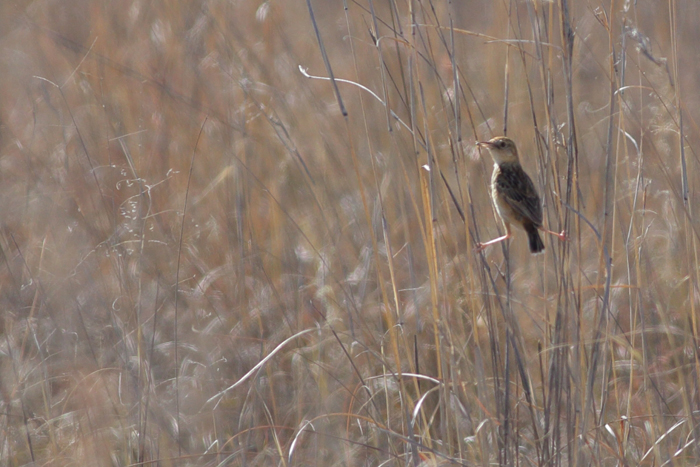 © Puff Addy
© Puff Addy
Mountain Zebra National Park
Links:
Species text Sabap1
Sabap2
Chamberlain's LBJ's
SASOL VOELS VAN SUIDER AFRICA (3de UIT)
 © Puff Addy
© Puff AddyMountain Zebra National Park
Links:
Species text Sabap1
Sabap2
Chamberlain's LBJ's
SASOL VOELS VAN SUIDER AFRICA (3de UIT)


